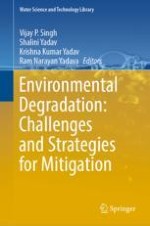This book discusses problems, challenges, and mitigation strategies in the wake of environmental degradation. It suggests proactive solutions to problems of environmental degradation for strategic planning as well as their effective delivery, and problems arising due to growth in population, industry, and land use change. The uniqueness of the book is its broader spectrum of coverage with related interconnections and interdependence of various aspects.
Presenting a wide spectrum of viewpoints and approaches, the book covers topics, such as deforestation impacts (land use and land cover, soil erosion); impacts on climate change and human health; treatment of industrial, municipal, biological waste disposal and their impacts on soil, water, and air; recovery/remediation processes and technologies; impacts of pesticides and chemical fertilizers on soil degradation and groundwater; socio-economic environmental sustainability; and socio-economic health impacts. Particular focus is placed on strategic planning and methodological handling of environmental degradation and remediation through various processes and treatment technologies.
This book will be useful to researchers, professionals, policy makers, and environmental engineers.
